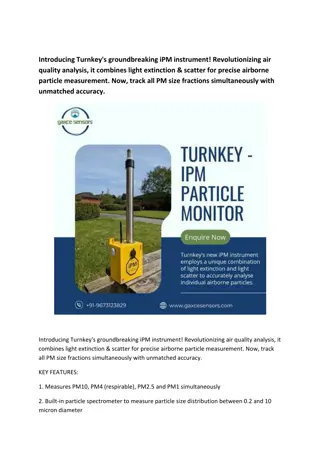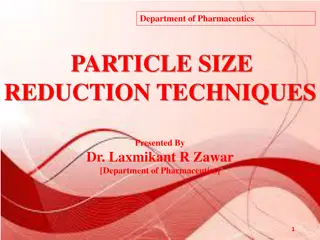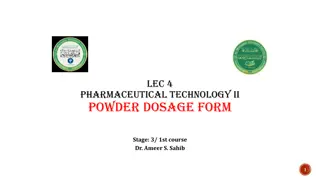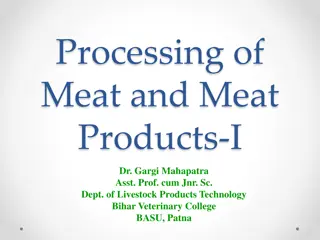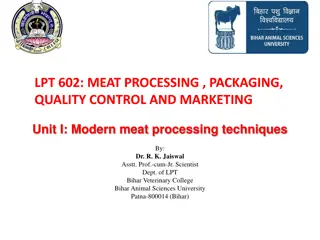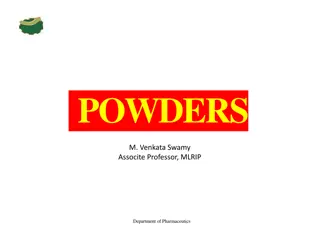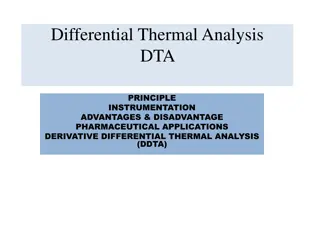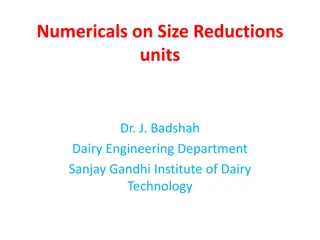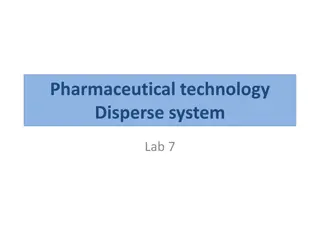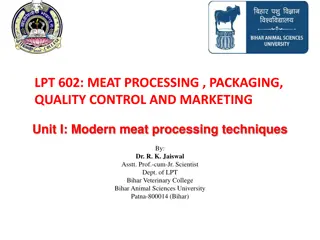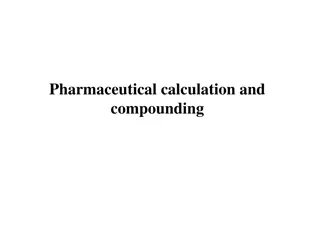Understanding Comminution and Particle Size Reduction in Pharmaceutical Processes
Comminution is the process of reducing particle size from larger to smaller particles, crucial in various industries like pharmaceuticals. This operation involves milling, grinding, and size reduction to make raw materials usable. The particle size plays a significant role in pharmaceutical formulations, affecting properties like flow, compression, disintegration, appearance, and texture. Factors like hardness, abrasiveness, stickiness, moisture content, and feed size influence the size reduction process. Additionally, particle size distribution and shape are essential considerations in ensuring product quality.
Download Presentation

Please find below an Image/Link to download the presentation.
The content on the website is provided AS IS for your information and personal use only. It may not be sold, licensed, or shared on other websites without obtaining consent from the author. Download presentation by click this link. If you encounter any issues during the download, it is possible that the publisher has removed the file from their server.
E N D
Presentation Transcript
COMMINUTION: The operation which involves the reduction of particle size from larger to smaller particles. also called size reduction, Milling, grinding. Raw materials often occur in sizes that are too large to be used and, therefore, they must be reduced in size. This size-reduction operation can be divided into two major categories depending on whether the material is a solid or a liquid. If it is solid, the operations are called milling, if it is liquid, emulsification or atomization. In the milling process, materials are reduced in size by fracturing them. The material is stressed by the action of mechanical moving parts in the milling machine and initially the stress is absorbed internally by the material as strain energy. When the strain energy exceeds a critical level, which is a function of the material, fracture occurs along lines of weakness.
Pharmaceutical importance of particle size In suspension too small particles form clay like sediment, while too large particles can settle down very fast. In solid dosage forms, the granule size is not only important for the flow property, but also for the compression, disintegration etc. In semisolid dosage forms the particle size is important for the appearance and texture of the product, and in addition for the feasibility to the surface. e.g. eye ointment. The extraction process is increased if the size is reduced. Lubricant has a fine powder in order to cover more surface are.
Particle size distribution The shape of the particle is irregular, and the size of particles varies within the range of the largest and smallest particles. No method has been developed to express the exact size and shape of a particle mixture. However, statistical methods have been developed to express the size of an irregular particle in terms of a single dimension reffered to as its diameter. Similarly there are various methods for representation of particle size distribution. The most precise method of data presentation is tabular form. Other methods are bar graph, or histogram of the frequency as a function of particle size . Size distribution data are commonly presented graphically because a graph is more concise and permit easy visualization.
Factors affecting size reduction 1. Hardness and toughness hardness difficult is the size reduction 2. Abrasiveness Abrasive material chances of contamination with metal worn from the grinding mill 3. Stickiness stickiness adherence to the grinding surface and choking of the mesh. 5. Softening with temp Many of the size reduction process generate heat. This may cause the softening of substance. 6. Structure Several substances have lines of weakness along which the material fracture in peaces. 7. Moisture contents Material should be dry or wet but not damp 8. Feed size Feed size should be optimum to avoid choking of the mill.
MECHANISMS OF SIZE REDUCTION There are four main methods of effecting size reduction, involving different mechanisms Cutting: as the name implies, the material is cut by means of a sharp blades Compression: in this the material is crushed by application of pressure. Impact: occurs when the material is more or less stationary and is hit by an object moving at high speed or when the moving particle strikes a stationary surface. In either case the material shatters to smaller pieces. Attrition: In attrition the material is subjected to pressure as in compression, but the surfaces are moving relative to each other, resulting in shear forces which break the particles.
Pistle and mortar
Size analysis of a powder Microscopy The most direct method By means of a calibrated micrometer eyepiece The hair line of the eye piece is moved by the micrometer to one edge of the particles, and the reading on the micrometer is recorded. The hairline is then moved to the opposite edge of the particle being measured, the micrometer is read. The difference in the reading is the size of the particle. Lower limit is 0.4 m. However, with latest lenses this may be extended to 0.1 m.
Sieving Cheap, simple and rapid Sample of powder through a series of successively smaller sieves. In other words, a number of sieves that fit into each other in a frame (i.e. a rack of sieves). The coarsest sieve is placed on top and the finest one at the bottom. Powder is passed successively over finer sieves and a series of fractions obtained. The percentage of fraction left on each sieve is calculated, which give a particle size distribution. Sieving does not give accurate results. NOTE: Sieve is a mesh made up of wire or nylon or a plate perforated with holes. The one used for particle size analysis is of wire type. Mesh number: The mesh number system is a measure of how many openings there are per linear inch in a screen.
Sedimentation This is based on the rate of sedimentation. The powder is dispersed in the liquid contained in a tall vessel (Andreasen apparatus). 10ml sample are withdrawn at predetermined times form a known depth bellow the surface and determined by evaporating the liquid and weighing the residue, in order to calculate the range of particle sizes present in each sample. Stokes s equation is used. This is only applicable in dilute dispersions where the concentration of solid is less than 2% w/w. In one of the methods the settlement rate is increased by using a centrifuge. Calculation of the results is by stokes s law, with an appropriate factor to indicate the number of times the centrifugal force is greater than the gravitational force.
Conductivity method One of the more recent particle size analysis procedure depending upon conductivity measurement is Coulter Counter. In which the particles are suspended in an electrically conductive fluid. The suspension flows through a suitable aperture with an immersed electrode on either side and the particle concentration is arranged so that only one particle travels through the aperture at a time. As the particle passes through the aperture, some electrolyte is displaced and changes the resistance between the electrodes which causes a pulse in the voltage. The magnitude of the pulse will be proportional to the size of the particles.
TYPES OF PHARMACEUTICAL MILLS Coarse milling: 20 Mesh Intermediate milling: 20-200 mesh Fine milling: 200 mesh A mill can operate in more than one mechanism. It has three basic parts 1. Feed channel 2. Mean of grinding 3. Discharge channel
The rate of feed should be equal to the rate of discharge. Mostly gravitational force is sufficient for discharge from bottom of the mill. However for ultra fine particles, air or inert gas is introduced to carry the milled product with it. The mills where the material is reduced to the desired size by passing once through the mill are called open circuit milling. The mills where the larger particles are redirected to the grinding chamber until reduced to smaller sizes are called closed circuit milling.
Cutter mill Mechanism of size reduction The mechanism of grinding is cutting. Design Features In such mills rotating knives are provided which rotates against the stationary knives in the casing, the lower portion is provided with screen, which can be adjusted. Such mills are used to reduced soft materials, the particle size obtain is coarser. Commonly roots, peels or woods are crushed prior to extraction.
Hammer Mill Design features: 1. feed inlet at top or center 2. Milling chamber, which contain 3. A rotor having swinging hammers 4. The plates at the inner surface of the casing 5. Perforated metal screen (forms the lower portion of the casing) Mechanism of size reduction Impact of the hammers against the plates in the internal wall of the mill. Operation Material is fed into the mill's chamber from top or center. The material is struck by swinging hammers which are attached to a shaft which rotates at high speed inside the chamber. The material is crushed or shattered by the repeated hammer impacts, and collisions with the walls of the grinding chamber. Perforated metal screens, covering the discharge opening of the mill retains coarse materials for further grinding while allowing the small sized materials to pass as finished product. Hammer speed 7600m/min at which every material behave as brittle. Hammers may be either blunt or cutting edges. Brittle material is best reduced by blunt hammers, while fibrous material by cutting edges. Size of particles are controlled by hammer speed and the size and type of
Advantages It is rapid in action, and is capable of grinding many different types of materials. No surface moves against each other, so that there is little contamination of the product with metal abraded from the mill. Disadvantages The high speed of operation causes generation of heat that may affect thermolabile materials or drugs containing gum, fats or resins. The rate of feed must be controlled, to avoid chocking of the mill. Application Milling of barks, leaves, roots, crystals, filter cakes.
Design: Diameter Balls Balls Diameter= mm Material of construction = = 30-50% of mill volume 75 mm, 150 mm, 20 1m = porcelain, rubber, metal
Ball Mill A ball mill, a type of grinder, a cylindrical device used to grind (or mix) materials like ores chemicals, ceramic raw materials and paints. Ball mills rotate around a horizontal axis, partially filled with the material to be ground plus the grinding medium. Different materials are used for media, including ceramic balls, flint pebbles and stainless steel balls. An internal cascading effect reduces the material to a fine powder. Industrial ball mills can operate continuously, fed at one end and discharged at the other.
Large to medium ball mills are mechanically rotated on their axis, but small ones normally consist of a cylindrical capped container that sits on two drive shafts (pulleys and belts are used to transmit rotary motion). A rock tumbler functions on the same principle. Ball mills are also used in pyrotechnics and the making of black powder but can't be used in the making of some pyrotechnic mixtures such as flash powder because of their sensitivity to impact. High quality ball mills are potentially expensive and can grind mixture particles ball mills are effective grinding systems in the general range of 500 microns down to 5 microns.
Advantages: Capable of grinding wide variety of material. It can be used in a completely enclosed form, which makes it suitable for toxic materials. It produces very fine powders Suitable for wet and dry milling.
Disadvantages: Wear and tear may occur which may results in product contamination. Soft or sticky material may cause problem by caking on the side walls or holding the balls. It makes a lot of noise specially in case of metallic material of construction.
Colloid Mill Colloid mill is used to reduce the particle size of a solid in suspension, or to reduce the droplet size of a liquid suspended in another liquid. Mechanism of size reduction This is done by applying high levels of hydraulic shear to the process liquid. It is frequently used to increase the stability of suspensions and emulsions. Design features: Consist of a high speed rotor (3000-20000rpm) and stator. The rotor and stator are cone shaped, and have three stages of increasingly grooves. The grooves change directions in each stage for increased turbulence. The stator can be adjusted to obtain the desired gap setting between the rotor and stator. material is fed from top through the hopper upon the rotor, the centrifugal force throws the material across the rotor on to the stator. The hydraulic shearing force (in the narrow gap b/w rotor and stator) tends the particles to break in to smaller ones. The milled material is discharged through an outlet and may be recycled.
ROLLER MILL Method of size reduction: Compression Construction and working principle: The roller mill has two cylindrical rolls of stone or metal, mounted horizontally, which are capable of rotating on their longitudinal axes. One roll is rotated directly and the other rotates freely. When material is placed above the rolls it is drawn in through the nip and the second roll is rotated b y friction. Diameter of the rolls: Few centimeter up to several meters The gap between the roll may be adjusted to control the degree of size reduction. Applications: Used for crushing or cracking seeds prior to extraction of fixed oils or bruising soft tissues (often after cutting) to aid solvent penetration.
Fluid Energy Mill The mill consist of loop of pipe with a diameter of 20-200mm and loop height normally 2 m. a fluid is injected at high pressure through nozzles at the bottom, giving rise to high velocity with turbulent circulation of the fluid. solids are introduced into the stream as a result of high degree of turbulence, impact and attrition forces occur between the particles
Advantages: The particle size of the product is smaller than that produced by any other method. Expansion of gases at the nozzles leads to cooling , thus counteracting the usual frictional heat. As there is no moving part, no chance of material abrasion so product contamination is avoided. Inert gases can be used in special cases. Having a classifier as an integral part, it permits close control of particle size.
Disdvantage The particles develop electrostatic charges which are difficult to remove from mill.
DESCRIPITION The fluid energy mill mainly used to grind the sensitive materials to the fine powder by the mechanism of impact and attrition forces applied by the air or inert gas from the nozzles presents in the chamber. Principle It works mainly on the principle of attrition and impact.
Basic parts The main basic parts present in the fluidized energy mill are as follows The inlet by which the solid material is introduced into the chamber which is made of stainless steel. The nozzles by which the air and the inert gas is introduced into the chamber at high pressure. The classifier from which the fine reduced particles are collected.
Construction It consists of a loop of pipe which has a diameter of 20 to 200 mm, depending on the overall height of the loop, which may be up to about 2 m. There is an inlet for the feed and a series of nozzles for the inlet of air or an inert gas. It also has an outlet with a classifier which allows the air to escape but prevents to pass until they become sufficiently fine.
Working In the operation of a fluid energy mill, gas of high energy content is introduced into a pulverizing chamber. The air or inert gas is introduced with a very high pressure through the nozzle. Solids are introduced into air stream through the inlet. Due to the high degree of turbulence, impact and attritional forces occurs between the particles. The fine particles are collected through a classifier. Fluid energy mill reduce the particles to 1 to 20 micron. To get a very fine powder even up to 5 micron the material is pretreated to reduce the particle size to the order of 100 mesh and then passed through fluid energy mill.
A size-reduction unit depending for its action on collisions between the particles, the energy being supplied by a compressed fluid, (e.g., air or steam) that enters the grinding chamber at high speed. Such mills will give a product of 5 micron or less.
Types There are two main classes of pulverizers Air swept pulverizer Air impact pulverizer Air swept pulverizers use air to transport particles to the pulverizing section of the apparatus. Air impact pulverizers use high speed air to pulverization of the particles. The products from both air swept and air impact pulverizers produces oversize particles and no need of further sieving or classifying.
Air Swept Pulverizer The particles along with air is fed into the mill inlet. The beater plates support the hammers and distribute the particles around the periphery of the grinding chamber. The hammers grind the solid against the liner of the grinding chamber. The beater plates rotate between 1600 and 7000 rpm (revolutions per minute) to reduce the size of the incoming particles. The classifier plate separates the fine product and exit through the discharge outlet. The material is back feed to the mill inlet through the recycle housing.
Air Impact Pulverizer In air impact pulverizers superheated steam or compressed air produces the force that reduces the size of large particles. It results in the smashing of the particles into smaller particles
PHARMACEUTICAL APPLICATIONS Pulverizers are commonly used for chemicals, pigments and food processing. The micro scale air impact pulverizer is used in laboratories, where small samples are needed. Fluid energy mills are used because of their advantages in fine grinding. The mill is used to grind heat sensitive material to fine powder. They have been used for the fine grinding of kaolin, zircon, titanium and calcium, alumina, but the energy consumed per ton of milled product is high. It is also an object to provide grinding of dry solids. The mill is used to grind those drugs in which high degree of purity is required. Contamination can be avoided and no excess heat is produced, pulverizers are suitable for materials that must remain ultra-pure and those that are heat sensitive. Even cryogenic applications can be reduced.
OTHER APPLICATIONS This invention is applicable to the size reduction of a wide variety of materials capable of generating a static charge in a fluid energy mill. Examples of these materials are aluminum oxide, ceramic frit, powder insecticides such as DDT, diatomaceous earth, feldspar, fluorspar, graphite, gypsum, iron ore, iron oxide, iron powder, limestone, mica, paint pigments, polymers, rare earth ores carbon, talc etc. The process involves no moving parts or screens and is suitable for virtually any friable or crystalline materials, even materials that are very abrasive
ADVANTAGES Air needed is free. Large range of sizes available. The mill is used to grind the materials to fine powder. The particle size of the powder can be controlled due to the use of a classifier. There is no wear of the mill and hence there is no contamination of the product. It is useful for grinding heat sensitive substances such as sulphonamides, vitamins and antibodies. Homogeneous blend.
DISADVANTAGES Energy consuming. High head space. Avoid coarse materials into the chamber. The fed device may be clogged with the clump materials. Special feeding devices should be provided for the feeding of the materials. One of the problems encountered with the use of compressed air is the generation of static electricity. Material recovered in the collection bags is difficult or impossible to remove by the normal blow back procedures.


